The cheerful Buddha, the angry Buddha, the healer Buddha, and even the Buddha of the future: we discover what depictions you can find of Buddha statues, why there are so many of them, and how a bodhisattva is different from the Buddha.
Buddhist sculptural tradition is exceptionally diverse, canonical, and simultaneously innovative. Covering its entire range in a brief guide is impossible, but we will attempt to provide several key points to help you navigate it. Using famous sculptural complexes and individual monuments as examples, we will explore the common foundations applicable to all regions, particularly focusing on the most frequently encountered characters and their distinctive features.
The Emergence of Statues and Their Role in Buddhism
The founder of Buddhist teachings, Siddhartha Gautama, is better known by the name he acquired after attaining enlightenment - Buddha Shakyamuni ("Awakened Sage from the Shakya clan"). The exact dates of his life are unknown, but scholars lean toward the 5th century BCE. However, statues of Buddha were not widespread for many centuries after his passing. This doesn't imply a complete absence of representations; early Buddhist reliefs are quite interesting. Here, Buddha is depicted aniconically, meaning non-pictorially. For instance, in the relief below, we can interpret that Buddha is implied by an empty saddle on a horse, shaded by an umbrella, and giant footprints. Collectively, these elements narrate the story of the "Great Departure," which signifies Buddha's escape from his father's palace.

Anandajoti Bhikkhu. Relief fragment of the eastern gate of the Stupa. Sanchi, India/Wikimedia Commons
It is assumed that this avoidance of directly depicting the figure of Buddha may be linked to the prolonged absence of cult anthropomorphic images in the Indian tradition as a whole. Alternatively, early Buddhists might have revered the idea of Buddha's complete departure from the world, his parinirvana, through this approach. However, around the 1st century CE, these beliefs began to change, and the first anthropomorphic images of Buddha emerged, primarily in the regions of Mathura (India) and Gandhara (Pakistan).
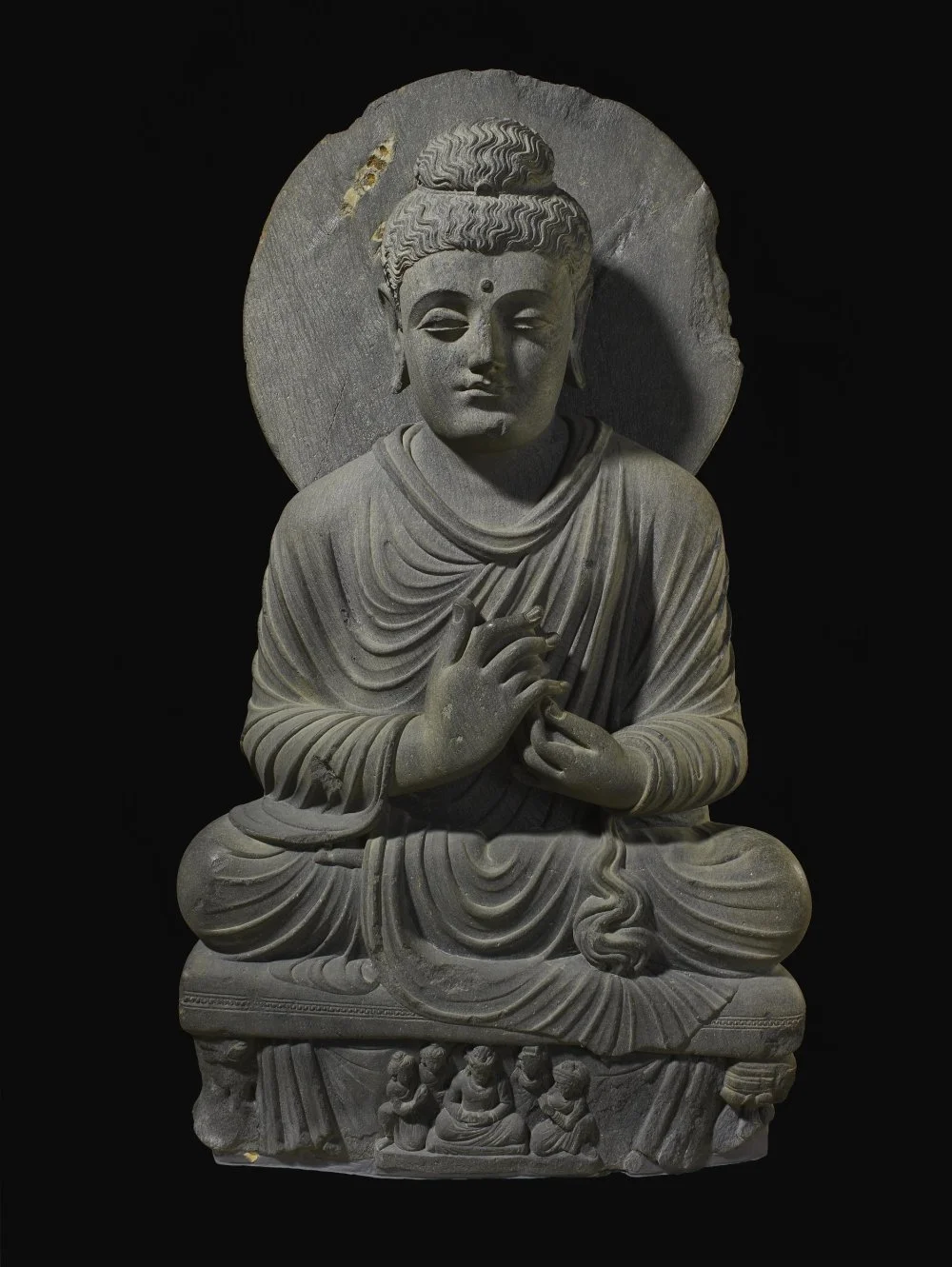
Sitting Buddha. Gandhara, India. 2nd-3rd century AD / The Trustees of the British Museum
The creation of images came to be regarded as one of the main ways to accumulate virtuous merit, essentially a "plus in karma." Venerating cult images and commissioning them for the sake of healing, ensuring a favorable afterlife, and other purposes are common practices in many world religions. Buddhism, in particular, exhibits a distinctive feature by establishing an early connection between image worship and relic veneration—statues often house sacred texts, remains, and substances even today. Furthermore, it's worth noting the role of images in sometimes complex visualization practices, where individuals learn to mentally recreate various Buddhist figures by observing statues and paintings. Finally, it's important to note that within Buddhism, there are three primary branches: Theravada, known as 'The Doctrine of the Elders,' Mahayana, often referred to as 'The Greater Vehicle,' and Vajrayana, known as 'The Diamond Vehicle.' There are also various different schools within these branches, and the role of statues and other images may be interpreted differently among them. This overview primarily focuses on Mahayana and, to some extent, Vajrayana."
How We Identify Characters
As the need for cult images of Buddha and other figures emerged, iconography gradually developed over many centuries as a standardized way to represent various characters. Iconography is primarily based on various sutras (sacred Buddhist texts, including the sermons of the historical Buddha Shakyamuni and others), oral traditions passed down by masters and monks, as well as the images themselves. Ancient revered monuments are replicated, scrolls acquired during pilgrimages, and small figures become sources for expanding iconographies, ultimately contributing to the creation of illustrated manuals for crafting these images. Naturally, artistic traditions, aesthetic preferences, and the prevailing ethnic characteristics of different regions—all of these factors and more continuously influence how Buddhist characters are depicted. For example, consider these three images:
These three statues span centuries (1–2nd century, late 5th century, 15th century) and cover vast distances (modern Pakistan, China, Thailand). However, we can identify all three as Buddhas based on several distinctive features: their simple monastic attire, elongated earlobes, a protuberance on the crown resembling a bun, and a dot on the forehead. We will delve into more detail about these characteristics below.
Certainly, without additional clues, we are often limited to this initial stage of character identification. In both the first and second cases, researchers simply refer to these statues as Buddhas. Still, in the second case, thanks to an inscription engraved during the statue's creation, they can be more precise—Buddha Maitreya. Additional attributes held by the characters or knowledge of specific gestures associated with certain figures during particular periods can also aid in identification. So, let's explore the main categories of Buddhist sculpture (Buddhas, vidya-rajas, bodhisattvas, deities, monks) and some of the most revered specific characters.
Buddhas
Buddha Shakyamuni is considered the Buddha of our era, but countless Buddhas have existed in the past, and more will emerge in the future. However, the first Buddha to be depicted was Buddha Shakyamuni (capitalized), and the aspects of his life served as the foundation for the depictions of all Buddhas. For instance, most Buddhas are portrayed wearing a simple triple-layered robe, which Shakyamuni adopted when he renounced his opulent court life and chose a path of seclusion. The arrangement of the robe on the figure may vary, influenced by the prevailing regional monastic attire, and sometimes it is omitted altogether, as it was originally made from real fabric.
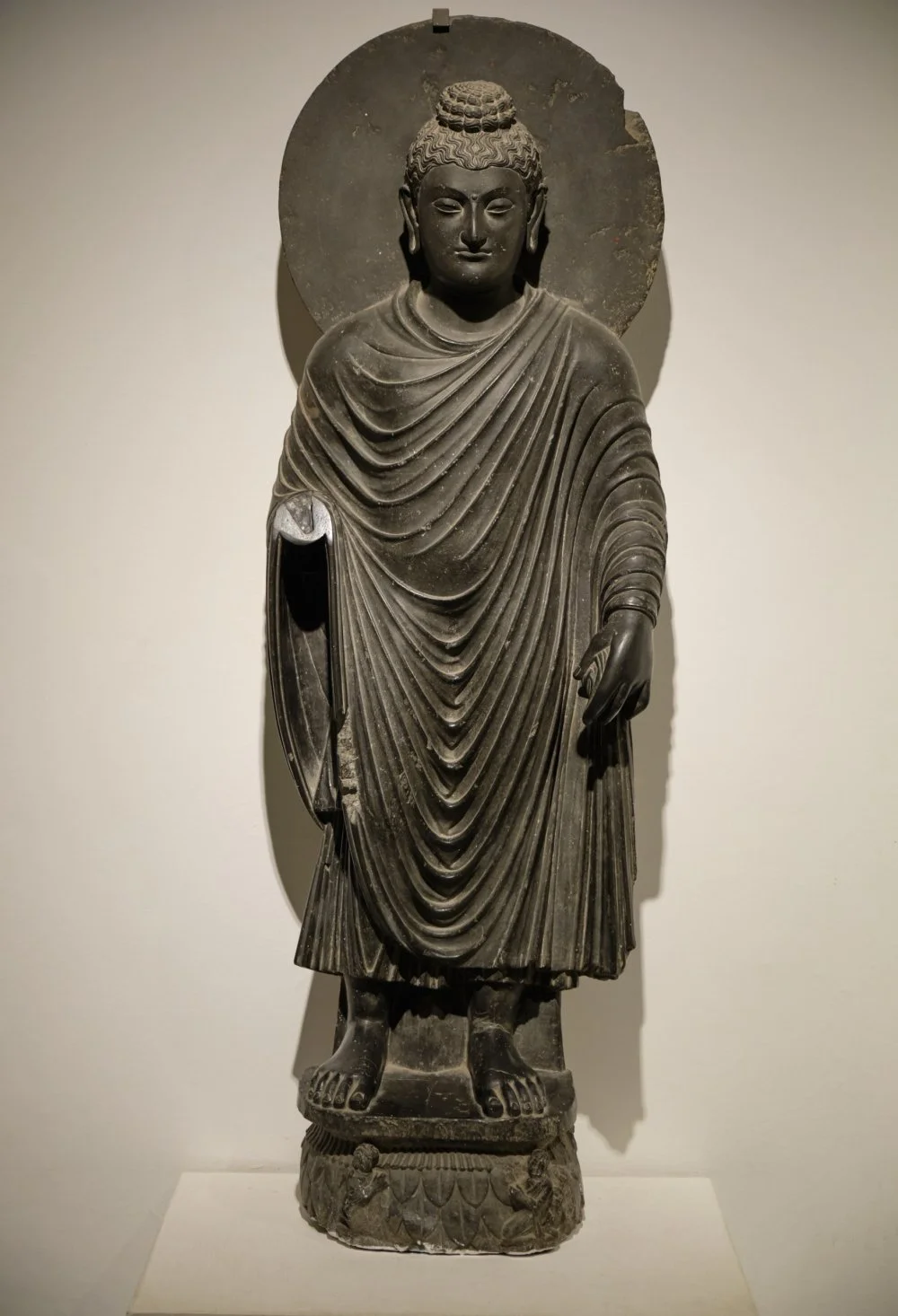
A greco-buddhist statue of a standing Buddha. The National Museum of India in New Delhi, India. 2nd century AD/Shutterstock
Buddha, through his moral virtues accumulated over countless lifetimes, underwent a transformation both spiritually and physically, becoming a supernatural being yet still beautiful by human standards. Of course, the issue of beauty's subjectivity is evident, which explains the stylistic variations in these statues. Nevertheless, over time, the sutras began to enumerate what are known as the "Marks of a Great Being" (comprising 32 primary and 80 minor marks). Among these, there are characteristics that we can easily recognize in depictions:
1. Golden skin tone and radiance - manifested through gilding on statues and the presence of a halo (a disc or complex-shaped background symbolizing light).
2. Torso and cheeks resembling those of a lion - characterized by powerful proportions.
3. A white, coiled hair between the eyebrows - the same dot on the forehead, known as urna.
4. A protuberance on the crown, referred to as ushnisha.
5. Black hair on the head - often depicted with blue pigment.
6. Hair that curls to the right - forming dense curls that cover the heads of statues.
7. Long ears - elongated earlobes with an opening.
8. Membranes between the fingers.
9. Symbols representing the teachings (the wheel of Dharma) on the soles of the feet and palms.

A fragment of a statue of the Healer Buddha. Yakushi-ji Monastery, Nara, Japan. 7th-8th century/yakushiji.cocolog-nifty.com
Other attributes of the Great Being are more challenging to assess from images (forty teeth, a long pink tongue, etc.). However, even those embodied in art don't always have a concrete, logical explanation, illustrating how iconography has developed over time, sometimes becoming intricate. For instance, the protuberance on the crown may have initially been a representation of a hair bun in sculptures and only later reinterpreted as a distinctive projection signifying extraordinary wisdom. The elongated earlobes might be indicative of Shakyamuni's past – heavy prince's earrings that stretched them.
Buddha Shakyamuni
Depictions of Buddha Shakyamuni often refer to specific significant moments in his life, identified through mudras – special hand gestures. For instance, the moment coinciding with his enlightenment at the end of meditation signifies the triumph over the demon of passion, Mara. The culmination of this episode is considered to be when Buddha calls the Earth as a witness – symbolized by the gesture of his right hand touching the surface on which the statue sits while the left hand remains in a meditation mudra.

Buddha with the gesture of touching the ground. Indian museum in Kolkata, India. 10th-11th century/Shutterstock
Buddha Amitabha
Buddha Amitabha, which translates to "Infinite Radiance," serves as the ruler of the Blissful Western Land. This land is accessible by invoking Buddha on one's deathbed and has gained immense popularity across East Asia. It has also found its place within Tibetan Buddhism, historically extending its influence to regions like Russia. We'll explore the image of Buddha Amitabha by taking the renowned Great Buddha of Kamakura in Japan as an example. In this representation, Buddha Amitabha is seated in a standard posture known as the lotus position. His hands rest on his legs in a meditative gesture, with a slight modification - the index and thumb fingers are joined in a circular form. The attire, although sizeable, doesn't overwhelm, characterized by numerous graceful folds. His countenance radiates concentration and a sense of meditative calm. Being in close proximity to this statue often evokes feelings of protection and amiability.

Buddha Amitabha. Kamakura, Japan. The middle of the 13th century/Benard E./Getty Images
Buddha the Healer (Bhaisajyaguru)
Another highly revered Buddha is known as Buddha the Healer or Buddha of Medicine. In Buddhism, characters often have dual roles, both literal and metaphorical. This Buddha not only heals physical ailments but also cures the ignorance that obstructs the path to enlightenment.
Enlightenment. Of course, the popularity of this Buddha is primarily based on the constant threat of illness that exists at all times. Statues of this Buddha were and continue to be commissioned along with prayers for the healing of loved ones or revered individuals. His depictions feature a small pot of medicine resting in his hand, typically the left hand, while the right hand is raised in a gesture of fearlessness. In Tibetan iconography, this Buddha also holds a flower or the fruit of the healing plant myrobalan.

Buddha the Healer. Shin-Yakushiji temple, Nara, Japan. 9th century/Wikimedia Commons
Vidyaraja
Within Buddhism, there exists another entirely distinct and formidable embodiment known as the wrathful form, the Vidyaraja, which translates to the "Lord of Knowledge." This represents an entire category of beings typical in East Asian Buddhism. They are nearly always depicted with a fiery halo, displaying expressions of anger, and adorned with other formidable attributes. Their purpose symbolizes a distinct kind of salvation - one that is not merciful but uncompromising and resolute. Their wrath is directed towards demons and obstacles, and they serve as protectors of the Dharma, which represents the teachings of Buddhism.

Sculptor Kaikeyi. Vidyaraja Acalanatha. 13th century/Metropolitan Museum of Art, USA
Bodhisattvas
Bodhisattvas, often referred to as "beings of enlightenment," belong to a distinct category of characters. They continue to appear in our world and actively participate in human suffering and efforts towards enlightenment. Bodhisattvas share some of the same characteristics as Buddhas, such as elongated earlobes, the urna mark, and a few other signs of the Great Being. However, one crucial distinction is that, unlike Buddhas, they are depicted in rich, regal clothing and adorned with various ornaments. On one hand, in sutras describing the emergence of various Bodhisattvas, it is often mentioned that they, like the Buddha himself, come from royal lineages. However, at the same time, their material beauty and wealth symbolize the spiritual merits of Bodhisattvas.
Bodhisattva of Compassion, Avalokiteshvara
Avalokiteshvara, known as the "Lord who listens to the world," or in the Chinese variant, Guanyin, the "One who listens to the sounds of the world," is one of the most popular figures in Buddhism, perhaps even more so than the Buddha himself. This popularity is linked to the vows of the Bodhisattva. In the sutras, various situations in which Avalokiteshvara provides salvation are elaborated upon in great detail, including protection from fire, floods, shipwrecks, imprisonment, bandits, murderers, and more. The concept of a universal protector is evident in many depictions of this Bodhisattva, but it is most pronounced in the iconography of the Thousand-Armed Avalokiteshvara. The attributes held in each hand symbolize the sphere of assistance provided by the Bodhisattva.
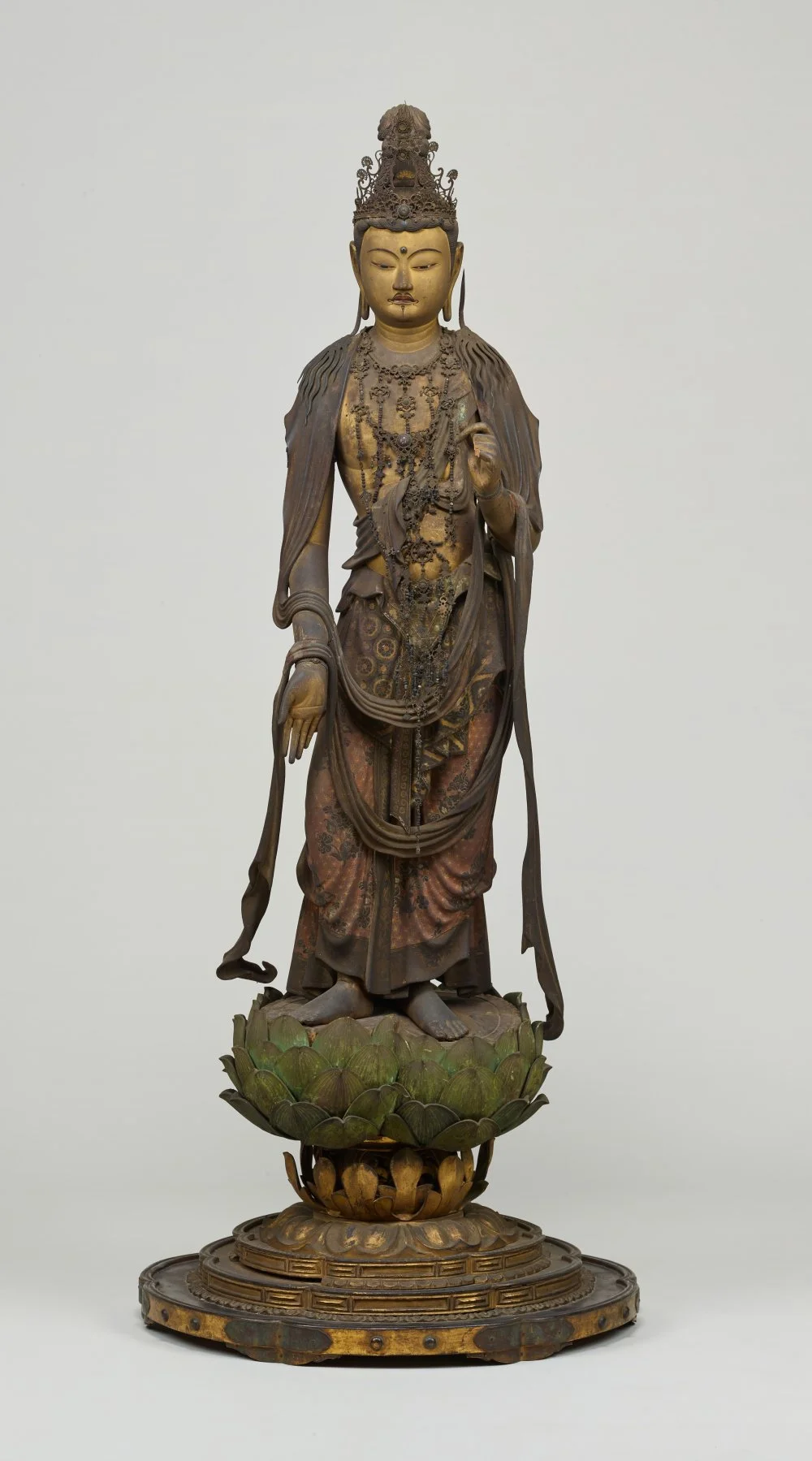
Bodhisattva. Tokyo national museum, Japan. 13th century/Wikimedia Commons
Another popular iconography of the Eleven-Headed Avalokiteshvara is associated with a touching legend: out of boundless compassion for the world, the Bodhisattva's head shattered, and then the merciful Buddha Amitabha collected all the pieces and placed them on top of his own head. It's worth noting that in a simpler representation of the Bodhisattva, we can still identify them by the figurine of Amitabha in their crown.
In Chinese art, the Bodhisattva is sometimes depicted in an elegant "royal pose," known as the iconography of "Guanyin of Water and Moon." It's worth noting that even though Bodhisattvas are essentially genderless beings, the image of Avalokiteshvara sometimes leans towards a more masculine or feminine appearance. Particularly in China, Avalokiteshvara acquired feminine features, giving rise to the iconography of "Guanyin, the Bestower of Sons." Such images were greatly embraced by Japanese Christians who had gone underground due to prohibitions and harsh persecutions (from the early 17th to the late 19th centuries). They revered these representations of Avalokiteshvara as likenesses of the Virgin Mary, often referred to as "Maria Kannon."

Maria Kannon. "Guanyin, the Bestower of Sons" Tokyo national museum, Japan. 17th century/Alamy
"Taking inspiration from the vows of Avalokiteshvara (known as Kannon in Japanese) to manifest in any suitable form for believers, the abbot of the Japanese monastery Kodaizi collaborated with scholars to conduct a provocative experiment: the Kannon robot. During the recorded session, the android engages in a virtual conversation about the fundamental concept of the emptiness of phenomena and recites the Heart Sutra, the most well-known and popular text associated with Kannon."
Bodhisattva Maitreya
Bodhisattva Maitreya, also known as the "friendly" one, is another highly revered figure. He is often referred to as the Buddha of the future because sutras contain a prophesy that he will become the next Buddha in the human world. As a result, he is sometimes depicted as a bodhisattva (before his arrival) and sometimes as a Buddha (afterward). His abode is in the Tushita Heaven, where his followers hoped to be reborn. The cult of Maitreya holds a special place in Korea and Japan, both of which borrowed extensively from the Korean Peninsula during the spread of Buddhism.

Android bodhisattva Kannon Mindar. Kodaiji Temple, Kyoto, Japan. 2017/Richard Atrero/Getty Images
The "European" seated posture, with both legs hanging down, is a distinctive feature of Maitreya's depictions. Perhaps through this posture, the concept of the transition of the Buddha-bodhisattva from the Tushita Heaven to the human world is conveyed.
Bodhisattvas Manjushri and Samantabhadra
Bodhisattva Manjushri, known as "Gentle Glory," plays a significant role in key sutras as a guiding force toward the right path. Consequently, he has come to symbolize transcendental wisdom. He is frequently portrayed riding a lion while wielding a sword, signifying the slashing of ignorance. In the Tibetan tradition, the attributes of bodhisattvas are often arranged in floral motifs on either side of the figure. In the case of Manjushri, these include the tip of the sword and a sutra book.
Bodhisattva Samantabhadra, known as "All-Pervading Wisdom," is often depicted in a triad with Buddha Shakyamuni alongside Bodhisattva Manjushri. Samantabhadra symbolizes the method (such as meditation practice) and provides special patronage to those who study the famous "Lotus Sutra." Samantabhadra is portrayed riding an elephant, as specified in this sutra.
Bodhisattva Vajrapani Vajrapani
Bodhisattva Vajrapani Vajrapani, known as the "Holder of the Thunderbolt" or "Vajra," first appeared in early Buddhist art in the Gandhara region (modern-day Pakistan). In these reliefs, Vajrapani serves as the protector of Buddha Shakyamuni, and his imagery was clearly influenced by the Hellenistic iconography of the strongman Hercules.
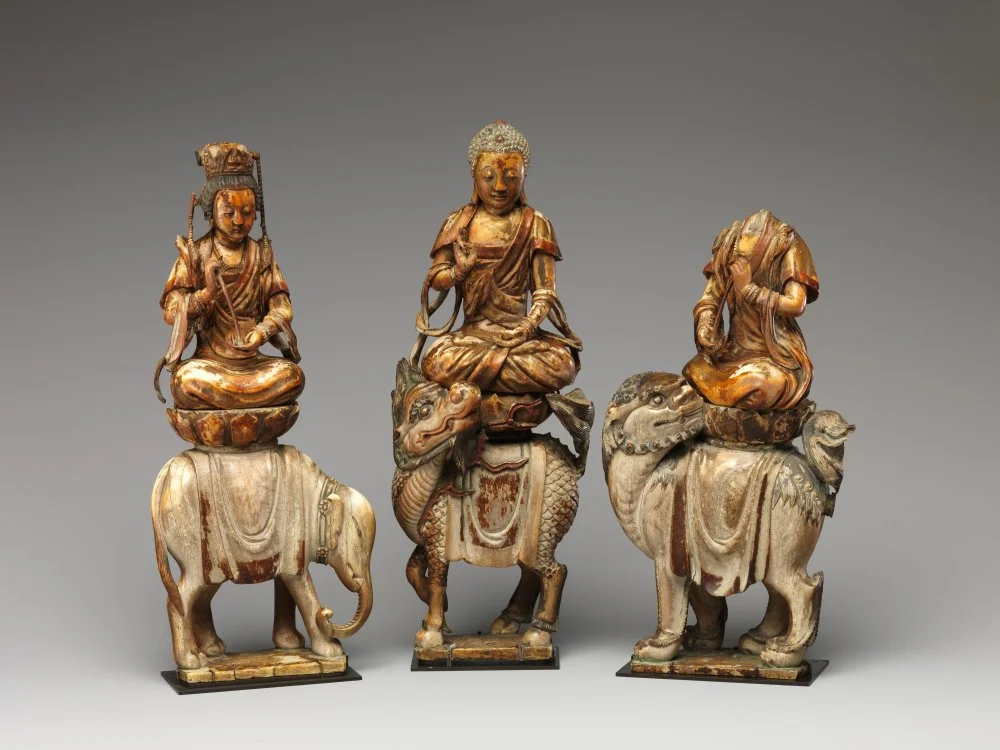
Triad of Shakyamuni Buddha with bodhisattvas Samantabhadra and Manjushri. China. 12th-14th centuries / Fletcher Fund/Metropolitan Museum of Art, New York.
In East Asia, Vajrapani is more closely aligned with the class of Dharmapalas, protectors of the teachings, rather than Bodhisattvas. He is commonly encountered as a guardian of the central figures of the altar or the monastery gate. In this context, he is not presented as a solitary figure but rather as part of a pair of fierce, muscular characters.
Deities
Here, we smoothly transition to the next class of beings - deities. In the Buddhist universe, deities hold an important but not the supreme position. It is believed that as they familiarize themselves with the Buddha's teachings, gods become inspired and make vows to protect and propagate it. This inclusive policy and the unique tolerance of Buddhism are among the reasons for its widespread dissemination.
In addition to Vajrapani, the most important figures among the protectors are the Four Heavenly Kings, deities of the cardinal directions. They are depicted as high-ranking warriors in ancient Chinese armor, each holding their own attribute. Often, beneath their feet, you can find figures of demons, symbolizing real and metaphysical enemies.

The Four Heavenly Kings. Hall of Heavenly Kings. Beihai park, Beijing, China/Rolf Müller/Wikimedia Commons
Many key deities from Hinduism have also found a place in the Buddhist pantheon. We will encounter the leaders of the gods, such as Indra, the creator Brahma, and Saraswati, the patron goddess of musicians. In Buddhist teachings, they each take on a slightly different interpretation compared to Hinduism.
However, Tibetan Buddhism stands out for its extensive pantheon of deities, encompassing a wide range of both Indian and local gods and goddesses. Among these divine beings, the most revered include compassionate goddesses like Green and White Tara, believed to have originated from the tears shed by Avalokiteshvara.
There are also terrifying yet fundamentally benevolent deities, such as Goddess Shri Devi and God Mahakala. These wrathful forms are similar to the Vidya-rajas discussed earlier, as they are also intended to eliminate passions and attachments. However, they belong to the category of "dharmapal" deities, the protectors of Buddhist teachings.

The God Mahakala. Tibet/Gift of Florence and Herbert Irving/The Metropolitan Museum of Art, New York, USA
Monks
Monks In both sutras and early artistic traditions, Buddhas are often accompanied by monks and arhats ("worthy ones," representing the highest level of holiness). These figures are distinctly human and are typically easy to identify: they have shaved heads, wear simple clothing, and sometimes have emaciated bodies due to ascetic practices.
Over time, the figures of specific disciples of the Buddha, known as arhats, gained special reverence and were depicted as a distinct group. While these individuals could not have been contemporaries of the sculptors, their depictions often contrast with the idealized appearance of Buddhas and bodhisattvas, displaying very distinctive and almost caricatured features.
This also applies to the patriarchs of various Buddhist schools, such as the renowned Bodhidharma (Chan school) or, in Japanese, Daruma. They are often depicted with wide-open fiery eyes. In Japanese tradition, Daruma was even simplified within popular beliefs into a toy-like Daruma doll with two giant eyes.

Daruma doll/Shutterstock
One of the most recognizable figures in Buddhism is that of a laughing, rotund man, a semi-historical Chinese monk from the 10th century known as Budai (Chinese for "cloth sack"). He became one of the most popular folk deities in China and Japan, associated with prayers for material well-being. According to legend, before his death, Budai revealed that he was an incarnation of the future Buddha Maitreya. However, the form in which Budai is depicted is certainly not that of a traditional Buddha.
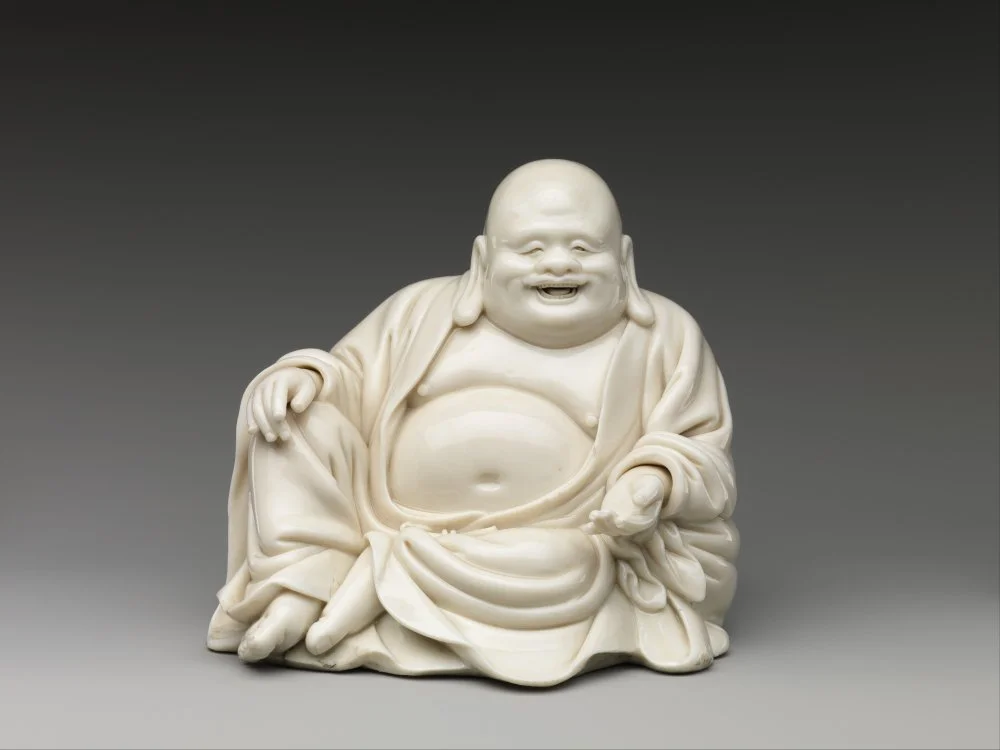
Monk Budai. China. 17th-18th centuries / The Friedsam Collection, Bequest of Michael Friedsam / The Metropolitan Museum of Art, New York, USA
In Tibetan tradition, depictions of lamas, or teachers, are of utmost importance and are very common. In Gelugpa monasteries, you will find a large number of statues depicting the founder Tsongkhapa and other leaders of the school. In Nyingma monasteries, images of the great yogi Padmasambhava are prevalent. The affiliation of the depicted figure to a specific school can often be determined by the unique hats they wear, which are distinct for each school.
The Buddhist Universe
In practically all major altar and rock-face compositions, attempts are made to depict the Buddhist universe in all its diversity and hierarchy. Let's explore several examples of how the character groups we've discussed coexist within a single complex.
In the Longmen Grottoes, a Chinese rock relief masterpiece from the Tang Dynasty (618-907), the central figure symbolizing the unity of all existence is Buddha Vairochana. Surrounding this central figure, there are arhats with shaven heads. Beyond them, we see bodhisattvas adorned with crowns and other ornaments. Continuing further, we encounter proud figures of heavenly kings and formidable protectors like Vajrapani.
In the Korean Sokkuram Grotto (724–774), the universe is fascinatingly integrated into an architectural space. In the main circular hall, Buddha Shakyamuni's figure dominates the scene. In the lower row and niches, there are depictions of arhats, bodhisattvas, and deities. In a narrow passage, the four heavenly kings can be seen, and the entrance is adorned with Vajrapani.

Shakyamuni buddha surrounded by bodhisattvas and deities. Sokkuram grotto. Korea, 742-774 / Alamy
The altar group in the lecture hall of the To-ji Monastery in Kyoto is one of the most intricate in Japan. It comprises five Buddha figures in the center, five bodhisattvas to the right, five vidya-rajahs to the left, along with three deities on each side. This is referred to as a three-dimensional mandala—a representation of a world in the dimension of Buddhas. All statues are crafted from numerous wooden components, coated with primer, gilding, and pigments." In essence, Buddhist art reflects the complexity of the human mind and its needs. Therefore, by studying it, we learn more about ourselves, and through curiosity, we overcome one of the main evils in Buddhism — ignorance."
References
1. Androsov V.P. Indo-Tibetan Buddhism. Encyclopedic Dictionary. Moscow: Orientalia, 2011.
2. Belozerova V.G. Traditional Art of China. Volume 1. Neolithic – 9th Century. Moscow, 2016.
3. Bir R. Tibetan Buddhist Symbols. Moscow: Orientalia, 2013.
4. Vinogradova N.A. Sculpture of Japan from the 3rd to the 14th Century. Moscow, 1981.
5. Elikhina Yu.I. Abode of Compassion: The Art of Tibetan Buddhism. Exhibition Catalog. St. Petersburg: State Hermitage Museum Publishing, 2015.
6. Torchikov E.A. Introduction to Buddhology: A Lecture Course. St. Petersburg: St. Petersburg Philosophical Society, 2000.
7. Fisher R.E. The Art of Buddhism. Moscow: Slovo, 2001.
8. Encyclopedia of Buddhism. Edited by Buswell Jr., ed. in chief. New York: Macmillan Reference, USA, 2004. Volumes 1 and 2.
9. Kim L. Buddhist Sculpture of Korea. Seoul: Hollym International Corp., 2007.
10. Leidy D.P. The Art of Buddhism: An Introduction to Its History and Meaning. Boston: Shambhala, 2008.
